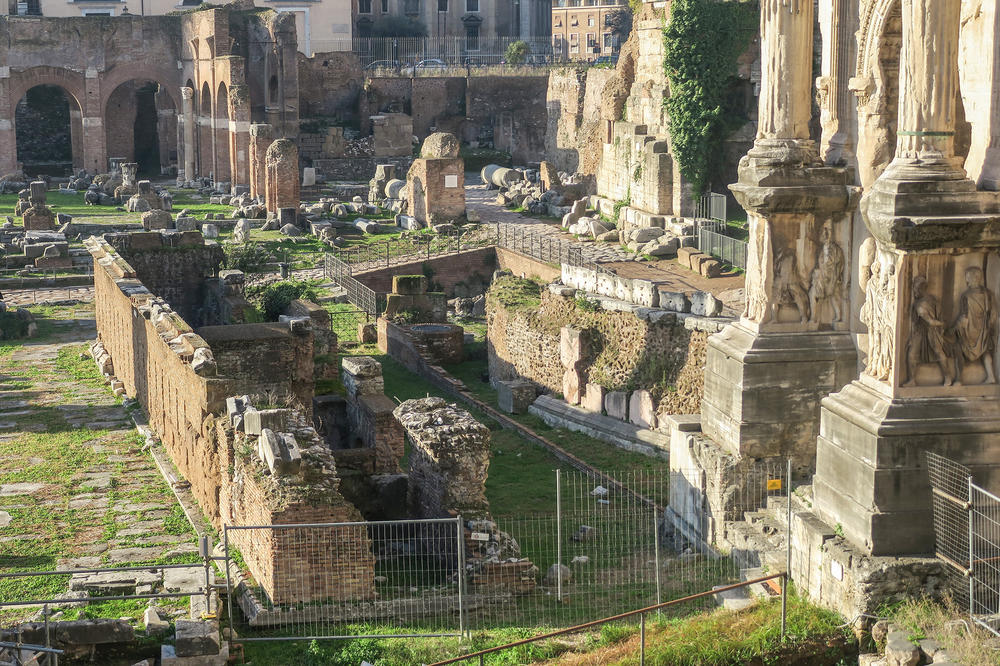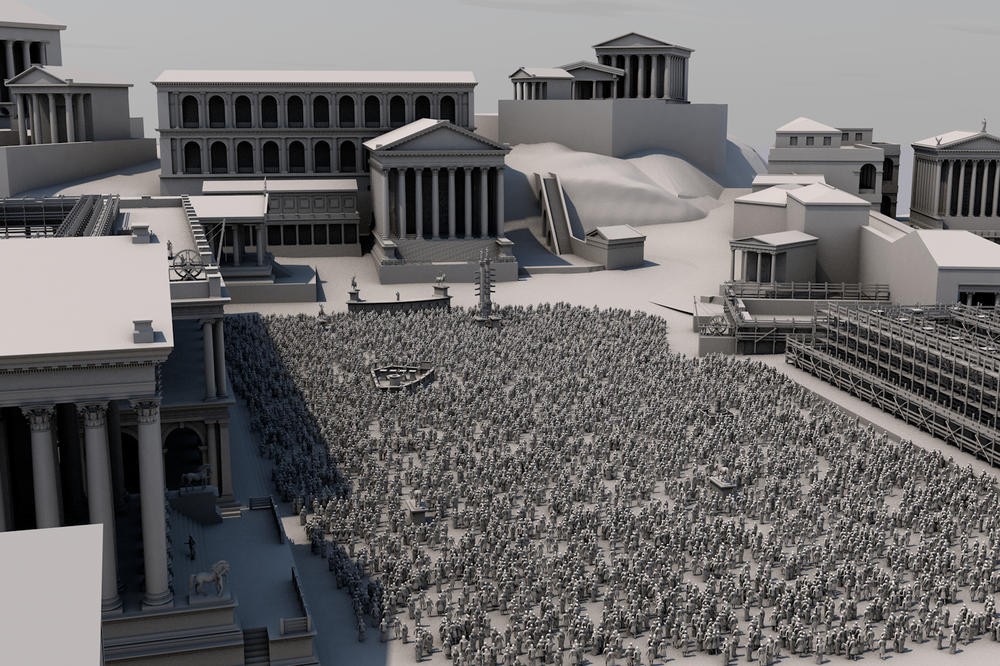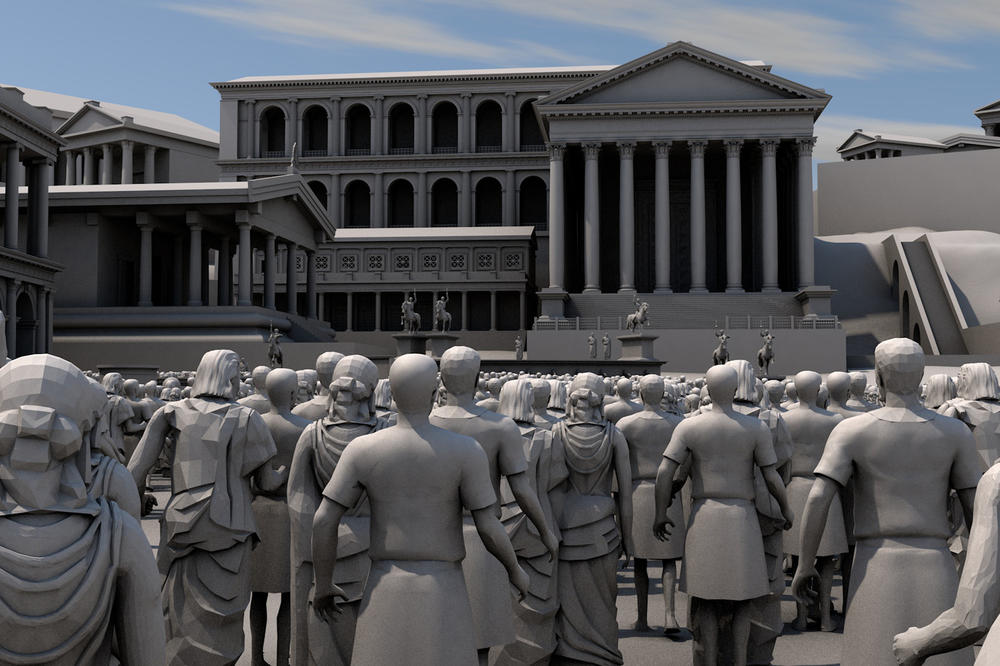Rhetoric Questions
An interdisciplinary team from Humboldt-Universität and Technische Universität is illustrating the challenges faced by speakers in ancient times – including at the Roman Forum.
Jul 11, 2018
The ruins of the Rostra at the Roman Forum: the Caesarean speaker’s platform with the curved front (in front the Augustan reconstruction with a straight end) in the background.
Image Credit: Susanne Muth
Ancient Rome’s most famous speaker is performing at the Rostra. But, at the Roman Forum, it is difficult to understand Marcus Tullius Cicero in the crowd below. The audience is able to catch some chunks of his third speech against Catiline before the rest of the sentence gets lost in the chatter. And nobody can see the orator anyway: the Forum slopes slightly and, of all places, the Rostra is set up at the lowest point. In real life, a Roman citizen might have pushed his way to the front. With only one mouse click, today’s listeners can have the computer simulate a new location for the Rostra at the Roman Forum. Cicero is now clearly visible and easy to understand.
What the scholars at Humboldt-Universität zu Berlin and Technische Universität Berlin are creating with their digital tools is a surprising experience. The interdisciplinary team led by archaeologist Susanne Muth has been researching the acoustics at the Roman Forum since 2015. The center of Rome, which tourists can still visit today, was the scene of political power struggles, public trials, and speeches. To adapt the Forum to the changing needs of the Roman state and its political elite, the Forum’s buildings and squares were repeatedly reconstructed over a period of over 1,400 years.
“The Forum’s elaborate digital visualization would not have been possible without the cooperation and ideas of the students.”
“In the Digital Forum Romanum research and teaching project, we have been creating three-dimensional models of the Forum since 2008,” says Susanne Muth, a professor of classical archaeology at Humboldt-Universität’s Winckelmann-Institut. The project is being carried out in cooperation between the Topoi Cluster of Excellence and the Architecture Department at the Deutsches Archäologisches Institut. According to Susanne Muth, the Forum’s elaborate digital visualization through all epochs of Roman history would not have been possible without the cooperation and ideas of her students. The two central elements of political life in the Forum, however, were missing in the models: the speakers and the audience – and, as a consequence, the acoustics. “We noticed very quickly that we were not able to explain every structural change in this urban space solely by reconstructing what was visible.”
This digital simulation shows the Roman Forum for a speech from the Caesarean platform from a bird’s eye view.
Image Credit: digitales forum romanum, S. Muth; A.Müller, D. Mariaschk
Above all, it is the Forum’s northwest corner which has been puzzling archaeologists over the last 100 years since its excavation. The citizens used to gather here at the Curia, the seat of the Roman Senate, in front of an elevated rostrum. “This area was under constant change from the 2nd century B.C.,” explains Susanne Muth. According to reports from written sources, for example, the speakers would turn around while the audience gathered on the other side of the Rostra – where there was more room. “Around 45/44 B.C., Caesar finally had the old Rostra in front of the Senate demolished and a new one built on the western side of the Forum.”
“Former researchers used the altered balance of power in the Roman state to explain this reconstruction.”
Visitors to Rome can still see the remains of the Rostra today. “Former researchers used the altered balance of power in the Roman state to explain this reconstruction.” By moving the rostrum away from the Senate, Caesar had wanted to show that he considered the old republican institutions obsolete,” says Susanne Muth. She agrees, however, that communication in the Forum was highly symbolic. The most important purpose of a rostrum is banal: the listeners must be able to understand the speaker. “That’s why we have to consider the experience itself, everyday life – and, this is very difficult for antiquity using established archaeological methods alone,” says Susanne.
Various disciplines, which normally have little to do with each other, came together at the “Image – Knowledge – Gestaltung” Excellence Cluster in 2015 to research the acoustics as a historic factor: classical archaeology, cultural studies, and audio communication. Besides Susanne Muth, Professor Christian Kassung from Humboldt-Universität and Professor Stefan Weinzierl from Technische Universität are heading the project “Analogue Storage Media II. Auralisation of Archaeological Spaces”. The visual model made it relatively easy for them to understand how much the audience saw of the speakers’ gestures and facial expressions, depending on the Rostra’s location. Finding out if it was also easy to understand the speakers required more effort. To start with, the actor Boris Freytag repeated the beginning of Cicero’s third speech against Catiline in an anechoic chamber.
Susanne Muth reports, “Like the speakers in Ancient Rome, he needed to speak loudly enough to theoretically be audible without any loudspeakers to tens of thousands of listeners. We felt sorry for Boris Freytag: he was exhausted after only a few minutes, despite being trained as a speaker.” At the same time, project members took “sound samples” of a listening crowd during a speech by the Pope on St. Peter’s Square in Rome. From the aspects of both the speech and the audience, computer programs simulated the sound landscape of the virtual Roman Forum and the various positions of the stage. Students then tested from which distance the speech could still be understood.
Digital simulation of the Roman Forum for a speech from the Caesarean rostrum as it looked to listeners from 70 meters away from the speaker.
Image Credit: digitales forum romanum, S. Muth; A.Müller, D. Mariaschk
“Our interdisciplinary cooperation was able to prove for the first time that the Forum was also reconstructed for acoustic reasons,” says Susanne Muth. Of all people, it was the famous speaker Cicero who, in December 63 BC, had to perform under very bad acoustic and visual conditions. The archaeologist assumes that Caesar and his advisers recognized the problem. “Acoustics as a scientific discipline did not exist in ancient times. But, in moving the rostrum, it shows that the engineers were experimenting.”
They found the best possible solution twelve years later with Caesar’s rostrum: significantly more citizens could now hear and see the speaker well. When the audience was comparatively quiet, it was still able to understand a speech’s most important, particularly pronounced passages, even when the Forum was filled to the last seat.
“For me, it was a revelation on what answers we find when other disciplines apply their skills to archaeological questions.”
Susanne Muth summarizes: “For me, it was a revelation on what answers we find when other disciplines apply their skills to archaeological questions.” This inevitably led to dozens of new questions: for example, does the sound of the Latin language carry further than the speech’s German translation? What influence did the climate have on the acoustics or the design of the facades? Acoustics at the Forum is proving to be an exciting field of research. In a new project in cooperation with Filmuniversität Babelsberg, various acoustic situations in the square are now to be reconstructed. Susanne Muth is looking forward to getting started: “There will be real soundscapes, sound landscapes with sacrificial animals, construction work, or market activities. Everyday life at the Roman Forum was probably as loud and chaotic as at an Oriental bazaar.”



